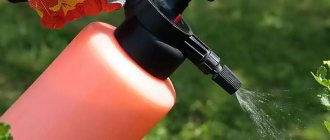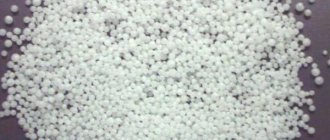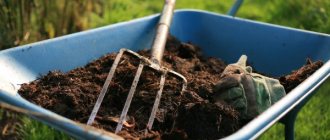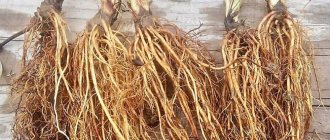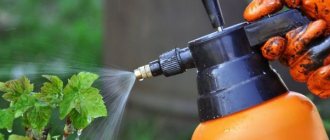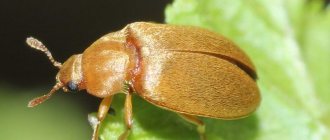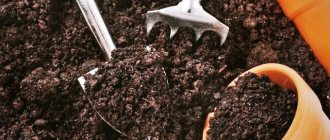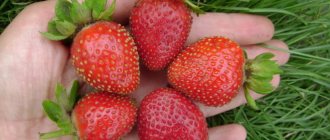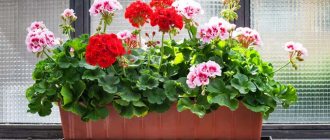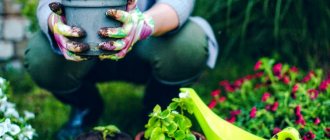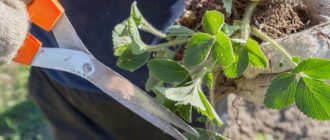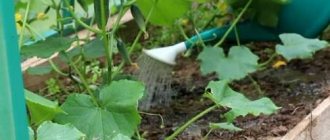Some substances used by gardeners have several effects at once: they can be fertilizers, but at the same time they can also protect plants from diseases and pests. This makes them valuable for use in home gardens. Vegetable growers use ammonia or an aqueous infusion of ammonia as a folk remedy for feeding garden crops, including strawberries. Many people are happy with its use. Find out about the features of feeding and treating strawberries with ammonia in the spring and during the season, recipes for preparing products and how to apply them correctly.
Ammonia in gardening and vegetable gardening
Ammonia, or a 10% ammonia solution, is widely used in gardening. This is due to the fact that with a high nitrogen content it does not contain ballast substances. A simple pharmaceutical product turns into an effective fertilizer. Its use allows you to get an environmentally friendly harvest without the use of chemical fertilizers.
Reference! Another name for ammonia is ammonium nitrate or aqueous ammonia.
An aqueous solution of ammonia has 2 functions in gardening:
- Liquid nitrogen fertilizer for any seedlings and adult plants;
- A preventive agent for pest control and infectious diseases.
Easily digestible nitrogen fertilizer is extremely important for most plants. Regular fertilizing with an aqueous ammonia solution is most important for the following garden crops:
- Strawberry (garden strawberry);
- Cucumbers;
- Clematis;
- Hydrangeas;
- Lilies;
- Geranium;
- Onion.
For other garden plants and vegetables, treatment with aqueous ammonia is a last resort.
Peculiarities! Ammonia fertilizer is practically not absorbed into plant tissue. This allows you to use it for spraying vegetables and fruit plants after flowering.
Using ammonia for strawberries
Nitrogen is one of the most important microelements for garden strawberries.
It is included in regular feeding carried out at the initial stage of the growing season.
Spraying with an aqueous solution of ammonia is more effective than root feeding with nitrogen fertilizers.
Reference! Nitrogen fertilizers can lead to an excess of this microelement in the soil. A good alternative is to spray the bushes with aqueous ammonia. At the same time, it is impossible to “overfeed” the plants.
Beneficial features
Regular feeding with aqueous ammonia allows you to obtain the following benefits:
- Increased growth of green mass;
- Active flowering of plants;
- Reliable prevention of pests such as aphids, mole crickets, ants and wasps;
- After such treatment, fertilizing with other mineral fertilizers is not necessary.
Another important advantage is plant safety. With this feeding, nitrates do not accumulate in the roots, leaves and berries.
Pest treatment
Ammonia is a very caustic and volatile substance with a pungent odor.
This allows it to be used to repel insects. Aphids, ants, slugs, nematodes and other pests will not settle in beds treated with it.
Regular treatment also allows you to get rid of insects living in the ground: mole crickets, May beetle larvae, weevils and root nematodes.
Peculiarities! Unlike chemical insecticides, ammonia can be used during the formation of the ovary. It does not accumulate in the fruits, making them easy to wash.
This is a good prevention of the appearance of infectious diseases such as gray rot, brown spot and others. A combination of this method and preventative mulching works well. Pine needles or straw are used for mulch.
How to properly process strawberries?
The procedure itself is not difficult, but there are a few things to consider.
- Early spring treatment is carried out after cleaning the bushes from last year's leaves and other debris that has accumulated over the winter. Water the Victoria after using ammonia - the solution will go deeper into the soil, killing harmful microflora and nematodes.
- It is convenient to use a regular garden watering can, choosing a nozzle with large holes - this way the solution will reach its destination faster, and the ammonia will not have time to evaporate. You can use a sprayer with a sprinkler attachment. This will allow you to wet the entire bushes with the solution, including the stems and the soil underneath them.
- Watering is carried out on damp soil to reduce the risk of root burns. It is also necessary to loosen the soil so that the solution penetrates to depth without delay.
- If strawberry beds are plagued by beetles (chafer larvae), wireworms, and nematodes, direct root watering is often used instead of sprinkling. Each bush needs 1 glass of solution. Sometimes it happens that after such a procedure the bushes droop a little, but then they quickly recover, bloom and bear fruit well.
- For processing, choose a dry, windless day, ideally cloudy, so as not to burn the above-ground parts. In sunny weather, in order not to delay processing, the beds are watered early in the morning so that the leaves and stems dry out before 10 o'clock.
How to dilute the solution
The base solution is as simple as possible to prepare. For this you will need:
- 10% ammonia;
- Water.
To prevent ammonia from evaporating, fatty acids are needed.
To do this, add 72% washing soap to the solution. This is a natural antiseptic that creates a thin protective film on the leaves. Air and water penetrate through it, but it creates reliable protection against diseases. To prepare such a solution you need:
- 1 piece of laundry soap;
- Ammonia;
- Water.
Grate the soap and dissolve in hot water. Mix soap solution and 10 liters of cold water. Then pour in ammonia and mix. Garden strawberries respond well to watering with aqueous ammonia in combination with iodine.
Attention! The prepared solution must be used immediately so that the ammonia does not evaporate.
Ammonia is a toxic substance; when using it, you must take the necessary precautions :
- When watering, you need to use personal protective equipment: a respirator and gloves;
- Do not add other substances or preparations to the solution except soap or iodine;
- If the prepared solution gets on exposed areas of the body, you should immediately wash them with soap and water. After this, it is recommended to consult a doctor;
- In case of poisoning with the solution, drink a glass of milk and immediately seek medical help.
After this treatment, the berries must be washed thoroughly. Be sure to warn everyone who will eat them.
Carefully! An ammonia aqueous solution is prepared only outdoors. It must not be stored or used indoors.
Precautionary measures
Using ammonia for the garden, and in particular for strawberries, does not require any special skills or knowledge.
Despite this, you should follow some rules so as not to harm yourself and the plants:
How to write articles for a website correctly
- Fertilizing strawberries
Planting strawberries in the fall: tips and recommendations on when and how to plant strawberries correctly. Scheme of planting in open ground and caring for seedlings (115 photos)
- Strictly follow the above proportions when mixing ammonia with water.
- When working, use protective equipment: gloves, a mask and long sleeves.
- Mix the ingredients outdoors. The pungent odor of the drug can cause discomfort and even irritation of the mucous membranes of the nose and eyes.
- Use specialized mechanical devices to spray fertilizer. Processing strawberries using improvised means (brush or broom) can lead to an overdose.
- Do not process strawberries during strong gusts of wind.
- For preventive treatment, it is permissible to use a watering can, but it is necessary to ensure that the liquid gets directly into the root zone and not onto the leaves.
- If the solution gets on the skin or mucous membranes, immediately rinse them with plenty of clean water. If you have other suspicious symptoms, seek help from a medical facility.
Dosage and stages of watering strawberries
To prepare the solution, use a 10% aqueous ammonia solution.
In order for treatment with its solution to bring only benefits, it is important to observe the dosage and frequency of use.
The procedure is repeated 2–3 times. Most often, watering with ammonia solution is repeated three times.
Attention! For each stage of irrigation, a freshly prepared solution of varying concentrations is used.
For watering, use a watering can with wide jets. The liquid quickly pours out, which is why the ammonia does not have time to evaporate. When spraying large areas of beds, the sprayer should be in the “jet” position. This is more effective than the "fog" mode. Drops of the solution also fall on the ground, scaring off pests inside it.
First stage, feeding in spring
The first watering is carried out in March - early April . It is important to carry out this immediately after the appearance of young leaves. To prepare the solution you will need:
- 1 bottle of 10% ammonia (40 milliliters);
- 10 liters of water;
- Soap solution.
The resulting mixture is poured into a watering can with a large nozzle and the bushes are generously watered. This allows the solution to reach the stems, leaves and soil simultaneously. To avoid chemical burns, water the plants with clean water afterward.
Peculiarities! The solution for the first watering is the most concentrated. It allows you to destroy pests that have overwintered in the soil and fungal infections.
Second phase
The second watering is carried out after flowering . For this, a less concentrated solution is used. For it you will need:
- 3 tablespoons of ammonia;
- 10 liters of water.
The bushes are first watered with plain water and then with aqueous ammonia. This will protect the ovary from pests that survived the first treatment. A lower concentration allows you to obtain the lowest possible concentration of nitrates in fruits.
Third stage of spraying
The third time the strawberry bushes are watered with an aqueous solution of ammonia after harvesting.
This is preparing the bushes for winter and the opportunity to ensure a generous harvest for the next year.
This is good support for plants that have exhausted their strength after fruiting.
As in the first stage, the most concentrated solution is used for this:
- 1 bottle of ammonia;
- 10 liters of water;
- 5 drops of iodine.
Water the bushes generously from a watering can with a sprinkler attachment.
Nitrogen fertilization
NH3H2O or, in the more familiar form of ammonium, NH4OH. That is, this substance is literally stuffed with nitrogen. Nitrogen in crop production is the green mass, the healthy and strong appearance of leaves and stems, and a developed root system.
But there are nuances in using ammonia as a top dressing that must be taken into account.
- Ammonia diluted in water in the dosages indicated below is largely used as a means of awakening flowering potted plants after hibernation. Plants that do not bloom can be content with this feeding no more than 2 times a month.
- The product is strong, so the 10% solution sold in pharmacies is not suitable in any case! Its use in its pure form will simply kill any plant. Therefore, the “impact” dose that forces plants to awaken after winter is 1.5-2 tablespoons of 10% ammonia per 5 liters of water.
- Plants should be fed with this product no more than once every 2 weeks, starting from about mid-February, when the length of daylight compared to the end of December becomes noticeable. Fertilizing is done regardless of the frequency of watering with ordinary water or the need of certain plants for nitrogen: this need must be satisfied in the composition of complex nitrogen-containing fertilizers.
- Diluting this liquid in water is also not so easy: ammonia will remain in it for a long time in layers, not wanting to mix. For complete dissolution, you need to use warm water, 30-35 degrees. After dissolving the ammonia in it, wait until it cools to room temperature.
- Fertilizing is carried out on damp soil, that is, the solution should be poured into flower pots 20-30 minutes after regular watering.
- Fertilizing plants with a solution is done strictly at the root! To do this, you need to have a special watering can with a thin spout, without a sprinkler at the end, which will allow you to pour the solution exactly under the root of the plant, preventing its drops from falling on the leaves, which can cause chemical burns. Despite the precautions taken, it is still possible for drops to accidentally fall on the green parts of the plant. To neutralize their effects, it is useful to spray the plants with plain water in the form of an aerosol immediately after watering.
- After the massive appearance of buds and the beginning of flowering, the dosage can be reduced by half - a tablespoon and a quarter of ammonia per 5 liters of water.
- In winter, such fertilizing can be avoided at all or limited to once a month.
